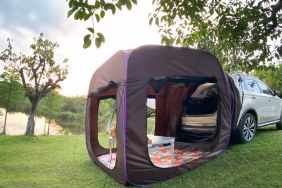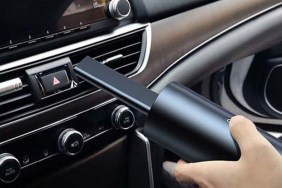Photo: Thomas Barwick (Getty Images).
An open road is the ultimate form of freedom. That must be why Americans love driving to their holiday weekend getaways. Travel on four wheels lets you experience the journey in a more intimate way and see more of the countryside than you could in a plane. Maximize your road trip by anticipating issues ahead of time and nipping them in the bud.
This checklist will have you prepared for whatever you encounter on your journey. Now all you need is a destination.
Tire Pressure Gauge: You’re not going anywhere if your tires give out. Make sure your tire pressure is where it’s supposed to be with a tire pressure gauge. Check your owner’s manual or the tire sticker on the door of your car for the operating pressure (not the maximum pressure listed on the side of the tire) before using your gauge. You should be within a pound or two of the recommended PSI (pounds per square inch). If you’re low, use the air hose at a gas station to inflate the tire, then check the pressure with the gauge again. If you overfill, use the knob on the end of the tire gauge to nudge the valve on the tire to release air. Remember to check the pressure of all four tires as well as your spare.
Spare Tire: Not only should you have a spare, you should know how to put it on your car. A full-size spare is preferable because you can drive longer on it. A typical “donut” spare will only last you between 50 and 70 miles and cannot tolerate speeds faster than 55 MPH. Don’t forget to check the condition of your spare and its tire pressure before you hit the road.
Full Fluids: Schedule a tune-up prior to your road trip to catch any mechanical problems before they ruin your vacation. At the very least, get an oil change and top off all fluids before your departure. It never hurts to have a jug of windshield wiper fluid in the trunk, either.
Gas: Fill up early and often to prevent getting stranded on the side of the road. A good rule of thumb is to stop at a gas station when the tank is 3/4 empty.
Map: Cell phones and navigation systems may be the most convenient ways to plot out your route, but they’re not foolproof. Aside from the danger of fiddling with a cell phone while driving, you could find yourself in a WiFi dead zone, run out of battery, or get a glitch. That’s why there’s no substitute for an old-fashioned road map. Make sure you have a map that covers the entire length of your journey and familiarize yourself without the route before you hit the road. When you arrive at your location, stop into the local visitor’s center and pick up an area map so you know where all the essential stops around town are located.
Also: Strapped: A Brief History of the Seat Belt
Emergency Kit: Even the best-kept cars have trouble sometimes. Be prepared for the worst with an emergency kit that includes duct tape, a flashlight with extra batteries, a lighter, a small fire extinguisher, jumper cables, a sleeping bag, and trash bags (which can double as ponchos!). Pack these items in a clear, plastic container (so everything is visible and waterproof) that has a secure lid (so items don’t scatter when the car is in motion) and store it in your trunk.
Road Flares: A car sidelined on a dark road is dangerous to both you and other motorists. Make sure your car can be seen with an emergency flare. Practice lighting one before you embark on your road trip because if it’s too dark to see your car, it’ll be too dark to read the instructions on a flare! To light a flare, stand with the wind to your back. Hold the flare by the bottom half. Remove the cap from the flare to expose the ignitor button. Hold the cap in one hand and the flare with the igniter button up in the other hand. Striking away from your body, strike the scratchy end of the cap against the ignitor button. If the flare won’t light, use a lighter to ignite the igniter button. Place the flare immediately on the pavement a few feet from your car.
First Aid Kit: There’s never a Band-Aid around when you need one, right? This is doubly true on the road. Prevent an inconvenience from becoming an emergency with a well-stocked first aid kit. You can make your own or buy one all ready to go at most major retailers. Your kit should include items like: antibiotic ointment, antiseptic, hand sanitizer, over-the- counter pain reliever, cotton balls, gauze, an Ace bandage, and tweezers. Bug spray and sunscreen are wise items to have on hand, too.
Cash and Coins: In case you lose your credit card en route or happen upon a gas station that doesn’t take plastic, make sure you have some cash stowed in the car. Bring a roll of quarters, too, because you might hit a toll road on the way. Quarters are also essential if you’re stopping in smaller towns, which may still have old-school parking meters.
Snacks: The best part of a road trip is stocking up on snacks before you leave, but make sure that some of your road trip stash includes protein so you stay satiated longer and prevent a blood sugar crash. Beef jerky, trail mix, granola, and peanut butter crackers are all non-perishable, fuss-free options. If you
have a cooler, throw in a package of cold-cuts, a few hard-boiled eggs, some Greek yogurt, cottage cheese, or a quart of milk, too. Fresh fruits and vegetables that travel well include apples, oranges, bananas, carrots, and celery. Avoid anything that can melt easily in a hot car (we’re looking at you, candy bars).
Beverages: Sober drivers are safe drivers, so hold off on the alcohol until you’ve arrived at your destination and are done driving for the day. During the ride, enjoy your soda, energy drinks, and coffee, but bring (and drink!) plenty of bottled water, too. And remember, don’t ever drink alcohol and drive!
Entertainment: It’s not a road trip without a killer playlist and some mindless reading materials (for passengers only!). Perfect your playlist ahead of time and make sure there’s enough music to soundtrack your entire trip so you don’t have to fiddle with your phone while driving.
A Driving Companion: Conversation will keep your alert, help pass the time, and lower your stress levels while driving, so choose your driving companion carefully! Bonus points if your companion is licensed and insured so you can tackle the miles in shifts. (Remember: sober drivers are safe drivers!) And don’t forget to take a few detours and have some fun along the way!









